2008 Dodge Grand Caravan SXT Review
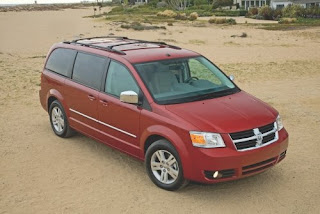 My family just spent a week using a Dodge Grand Caravan SXT as a temporary replacement for our own 2008 Toyota Sienna Limited. I was actually very curious to see how the Dodge stacked up not only against a higher-end Toyota, but also against its own cousin, the Chrysler Town & Country, which I tested for a week last month.
My family just spent a week using a Dodge Grand Caravan SXT as a temporary replacement for our own 2008 Toyota Sienna Limited. I was actually very curious to see how the Dodge stacked up not only against a higher-end Toyota, but also against its own cousin, the Chrysler Town & Country, which I tested for a week last month.
Both vans are new for the 2008 model year; as always, Chrysler chose to set their vans apart from the competition by offering some unique interior features, including Stow ‘n Go second row seats that fold flat into the floor (the Japanese competition doesn’t do that), an available hard disc music and photo storage system, Sirius Backseat TV, dual overhead DVD/TV screens, indirect interior lighting, and more. The vans also feature an exterior shape that has taken a step closer to functional and a step away from the ovoid, swooping design of the previous model. The upshot is that the boxier shape leads to a more usable interior, but the downside is that an already unfashionable vehicle has even less style. Another change for the Grand Caravan for 2008 is that all Caravans are “Grand;” the regular wheelbase value-leader model was dropped from the lineup. Chrysler’s hope is to move would-be short wheelbase Caravan buyers into the new 2009 Journey crossover.
Exterior
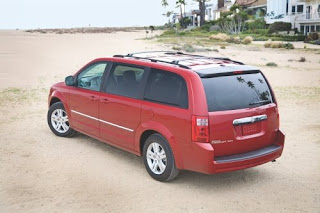 The first thing I noticed about the Grand Caravan is that its grille treatment, while slightly more attractive than the Town & Country’s to my eyes, also looks a bit too similar to the rental car favorite Dodge Avenger sedan. The design of the Grand Caravan is basically identical to the Town & Country, with the exception of details such as the grille and trim. Body stampings are all the same between the vehicles, so the bulges around the wheel openings – really the only interesting styling feature on the entire van – that looks good on the Town & Country also looks good on the Grand Caravan. My test vehicle was equipped with chrome-finish 16 inch aluminum wheels, which nicely set off the metallic black exterior, and the Dodge also included a chrome molding along the side similar to the one that I felt really dressed up the identically-colored Chrysler version that I tested.
The first thing I noticed about the Grand Caravan is that its grille treatment, while slightly more attractive than the Town & Country’s to my eyes, also looks a bit too similar to the rental car favorite Dodge Avenger sedan. The design of the Grand Caravan is basically identical to the Town & Country, with the exception of details such as the grille and trim. Body stampings are all the same between the vehicles, so the bulges around the wheel openings – really the only interesting styling feature on the entire van – that looks good on the Town & Country also looks good on the Grand Caravan. My test vehicle was equipped with chrome-finish 16 inch aluminum wheels, which nicely set off the metallic black exterior, and the Dodge also included a chrome molding along the side similar to the one that I felt really dressed up the identically-colored Chrysler version that I tested.
Interior
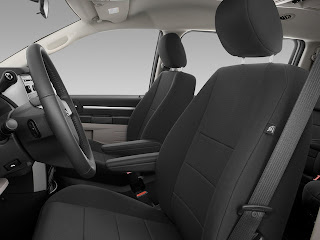 The interior of the Grand Caravan is both spacious and functional. As I’ve said before, Chrysler’s engineers clearly focused much of their attention on making the vans as family-friendly as possible, which was probably a better choice than making the vans more attractive but less functional. The design theme of the Grand Caravan SXT was one of hard plastics, sharp angles, and dark colors. Having experience with the high-end Town & Country just a few weeks ago, it was readily apparent where the much of the extra $13,000 price advantage that the Dodge enjoys came from: the interior. Over the past few days, I’ve gotten pretty good at spotting “missing” features that my particular Dodge did not have, but the Chrysler did. For instance, a 3 inch square cubby between the air vents on the center stack resides where the analog clock lives in the Chrysler; two of the four flip-down storage compartments in the overhead console take the place of the drop-down dual DVD screens in the Town & Country; black and grey plastic takes the place of the attractive faux wood that the Chrysler had; a conventional radio head unit
The interior of the Grand Caravan is both spacious and functional. As I’ve said before, Chrysler’s engineers clearly focused much of their attention on making the vans as family-friendly as possible, which was probably a better choice than making the vans more attractive but less functional. The design theme of the Grand Caravan SXT was one of hard plastics, sharp angles, and dark colors. Having experience with the high-end Town & Country just a few weeks ago, it was readily apparent where the much of the extra $13,000 price advantage that the Dodge enjoys came from: the interior. Over the past few days, I’ve gotten pretty good at spotting “missing” features that my particular Dodge did not have, but the Chrysler did. For instance, a 3 inch square cubby between the air vents on the center stack resides where the analog clock lives in the Chrysler; two of the four flip-down storage compartments in the overhead console take the place of the drop-down dual DVD screens in the Town & Country; black and grey plastic takes the place of the attractive faux wood that the Chrysler had; a conventional radio head unit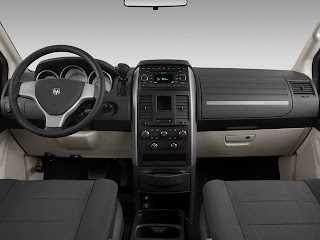 replaces the touchscreen navigation system featured in my Chrysler test vehicle; YES Essentials stain resistant cloth seats replaced the leather seats in the Town & Country. Other features lacking in the Dodge that were found in the Chrysler were automatic tri-zone climate control (the Dodge had tri-zone climate control, but it was manual); the thinner, less comfortable Stow ‘n Go seats instead of the less functional but more comfy Swivel ‘n Go seats and built-in sunshades to make it easier for little ones to sleep in the car. (The Stow ‘n Go seats, while forced to sacrifice some comfort and padding in the name of storage, really are a pretty neat piece of engineering.) The result, equipment-wise, was a van that kept nearly all of the family friendly necessities such as Sirius satellite radio, dual power sliding doors, remote keyless entry, privacy glass, power front seats, a six-speed automatic transaxle, and a trip computer, but lacked the more expensive “nice-to-have” comfort items that some pampered car owners in 2008 have become accustomed to having.
replaces the touchscreen navigation system featured in my Chrysler test vehicle; YES Essentials stain resistant cloth seats replaced the leather seats in the Town & Country. Other features lacking in the Dodge that were found in the Chrysler were automatic tri-zone climate control (the Dodge had tri-zone climate control, but it was manual); the thinner, less comfortable Stow ‘n Go seats instead of the less functional but more comfy Swivel ‘n Go seats and built-in sunshades to make it easier for little ones to sleep in the car. (The Stow ‘n Go seats, while forced to sacrifice some comfort and padding in the name of storage, really are a pretty neat piece of engineering.) The result, equipment-wise, was a van that kept nearly all of the family friendly necessities such as Sirius satellite radio, dual power sliding doors, remote keyless entry, privacy glass, power front seats, a six-speed automatic transaxle, and a trip computer, but lacked the more expensive “nice-to-have” comfort items that some pampered car owners in 2008 have become accustomed to having.
On the Road
Not surprisingly, the Grand Caravan drove very similarly to the Town & Country, in spite of its less-refined and less-powerful 3.8 liter overhead valve engine (the Town & Country had the optional 4.0 liter SOHC V6 but the same six-speed automatic). The steering and brakes felt basically identical between the two vans, although the Chrysler had a nicer steering wheel with controls for the upgraded trip computer on it.
Engine power from the 197 horsepower (230 lb-ft of torque) 3.8 liter V6 seemed adequate for most conditions; only when rapidly accelerating was the power deficit against the optional 4.0 liter V6 (251 horsepower and 259 lb-ft of torque) noticeable. This makes sense because generally OHV engines like the 3.8 liter are stronger in the lower RPM range, and the torque figures are not far apart. In the higher end of the tachometer’s travel, the missing horsepower can be felt. But really, most people probably would not notice the difference. The six speed automatic, as it did in the Town & Country, made the most of the engine’s power, with a low first gear for quick starts and a relatively serene sixth gear for high-efficiency cruising. (The engine turned at about 2,000 RPMs at 70 miles per hour in sixth gear). I did not bother to manually shift the transaxle in the Grand Caravan as I did in the Town & Country, since I figured there wouldn’t be much to learn from the experience that I hadn’t already witnessed. Plus, the 3.8 liter wasn’t as inclined to enjoy revving as the 4.0 liter was. However, that same capability is built into the dash-mounted gearshift lever.
I still found it relatively easy to break the tires loose from a stop, though it didn’t happen to me as often as it did in the Town & Country. Most likely, owners would become accustomed to the throttle tip-in and this would not be an issue for them.
While I didn’t spend any time in stop-and-go traffic in the Dodge (which I did in the Chrysler), I experienced none of the abrupt gear change thunk as the transaxle tried to decide what gear to be in with the Town & Country. The transaxles are identical between the two; the Grand Caravan only had about 2,500 miles on the odometer while the Town & Country had about 7,500 miles, but otherwise, it seemed to shift more cleanly than the Chrysler did.
Fuel Economy
Although I did not drive the same route in the Grand Caravan that I did in the Town & Country a few weeks earlier, my actual fuel economy was similar around town. Highway mileage was also very similar between the Dodge with the 3.8 liter and the Chrysler with the 4.0 liter. EPA ratings bear out my experience; they are identical for both the optional 4.0 liter and standard (on the SXT) 3.8 liter at 16 city/23 highway (18 combined). These ratings are slightly below the Odyssey with VCM (17/25; 20 combined) and Sienna 2WD (17/23; 19 combined). In my testing, which included a mix of highway driving, back roads, and city traffic, I got about 19 mpg (I got 17 mpg in the Town & Country, but spent more time on the highway and less time in traffic in the Dodge.
Pricing
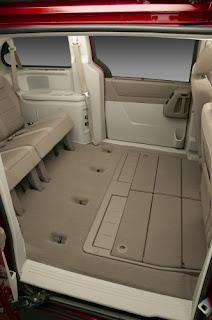 The Grand Caravan comes in SE value (base), SE and SXT trim levels, with several sub-packages under the SXT level containing more and more enhancements. All Chrysler and Dodge minivans currently have a $2,500 rebate, which definitely enhances their value proposition to buyers. A base SE value begins at $22,700 ($20,200 after incentives) and includes the full complement of airbags, Stow ‘n Go second row seats, front-only air conditioning, the 3.3 liter engine and a four-speed automatic transaxle, and not much else. The SE level for $26,390 ($23,890 after incentive) adds rear air conditioning, power windows, cruise control trip computer, power adjustable pedals, YES Essentials stain-resistant seat fabric, and more. Finally, the SXT costs $27,910 ($24,410 after incentive) and mainly adds the six-speed automatic transaxle and 3.8 liter V6. Other packages for the SXT add the 4.0 liter V6, UConnect Bluetooth cell phone connection, satellite navigation, Sirius satellite radio and Backseat TV, and more. When adjusting for features using TrueDelta.com’s tools, the Grand Caravan comes in at $625 less expensive when comparing a loaded Grand Caravan to a loaded Town & Country. Some features are not available in the Grand Caravan, such as surround sound, memory seats, HID headlamps, and an analog clock, so the most expensive Grand Caravan is about $1,500 less than the most expensive Town & Country.
The Grand Caravan comes in SE value (base), SE and SXT trim levels, with several sub-packages under the SXT level containing more and more enhancements. All Chrysler and Dodge minivans currently have a $2,500 rebate, which definitely enhances their value proposition to buyers. A base SE value begins at $22,700 ($20,200 after incentives) and includes the full complement of airbags, Stow ‘n Go second row seats, front-only air conditioning, the 3.3 liter engine and a four-speed automatic transaxle, and not much else. The SE level for $26,390 ($23,890 after incentive) adds rear air conditioning, power windows, cruise control trip computer, power adjustable pedals, YES Essentials stain-resistant seat fabric, and more. Finally, the SXT costs $27,910 ($24,410 after incentive) and mainly adds the six-speed automatic transaxle and 3.8 liter V6. Other packages for the SXT add the 4.0 liter V6, UConnect Bluetooth cell phone connection, satellite navigation, Sirius satellite radio and Backseat TV, and more. When adjusting for features using TrueDelta.com’s tools, the Grand Caravan comes in at $625 less expensive when comparing a loaded Grand Caravan to a loaded Town & Country. Some features are not available in the Grand Caravan, such as surround sound, memory seats, HID headlamps, and an analog clock, so the most expensive Grand Caravan is about $1,500 less than the most expensive Town & Country.
Bottom Line
There really wasn’t anything wrong with the Dodge Grand Caravan, per se. It had every family necessity that modern minivan buyers expect. It was comfortable during a four-hour round trip highway journey for my wife and me. Although I do prefer the Chrysler to the Dodge, a lot of that preference may be because I was spoiled by driving the flagship first, then seeing obviously the missing features and interior trim that the Chrysler included. Had I driven the Dodge first, and not been spoiled previously by the concept of a “luxury minivan,” my impression of the Dodge might have been different. But, for about $25,000 after rebates, the Dodge was a heck of a family hauler. However, I’m not sure that could necessarily be considered a value relative to the Town & Country Limited, because the Town & Country literally throws nearly every conceivable comfort feature found in any minivan at you. The Dodge costs a lot less (about $14,000 less), but also gives you a lot less stuff. For some people, that might not be a problem; for me, I’m spoiled and would want a van with everything.




